The Intel Skylake i7-6700K Overclocking Performance Mini-Test to 4.8 GHz
by Ian Cutress on August 28, 2015 2:30 PM ESTCPU Tests on Windows: Professional
Cinebench R15
Cinebench is a benchmark based around Cinema 4D, and is fairly well known among enthusiasts for stressing the CPU for a provided workload. Results are given as a score, where higher is better.

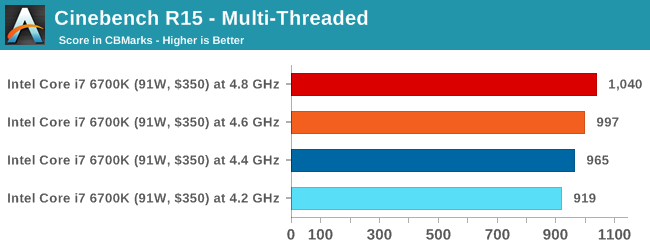
Agisoft Photoscan – 2D to 3D Image Manipulation: link
Agisoft Photoscan creates 3D models from 2D images, a process which is very computationally expensive. The algorithm is split into four distinct phases, and different phases of the model reconstruction require either fast memory, fast IPC, more cores, or even OpenCL compute devices to hand. Agisoft supplied us with a special version of the software to script the process, where we take 50 images of a stately home and convert it into a medium quality model. This benchmark typically takes around 15-20 minutes on a high end PC on the CPU alone, with GPUs reducing the time.
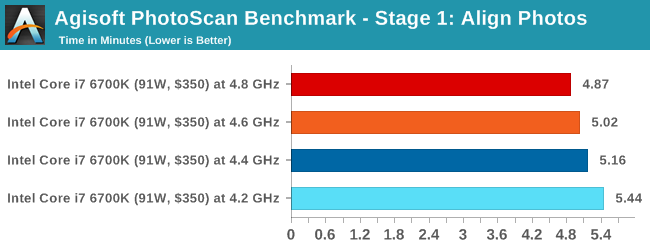
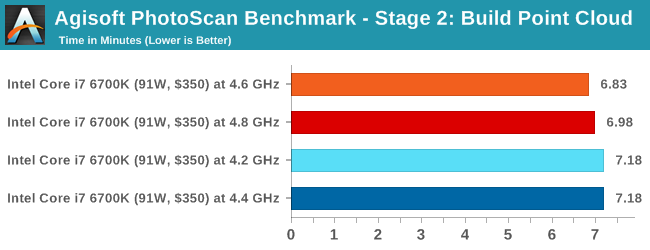
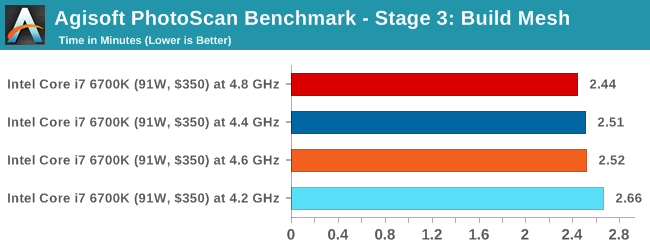
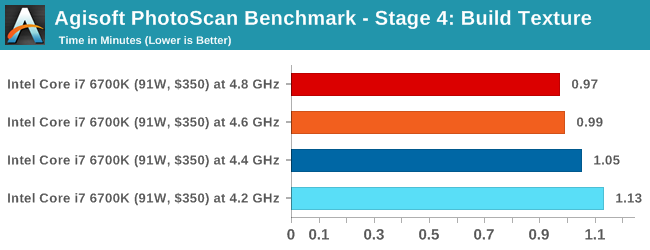
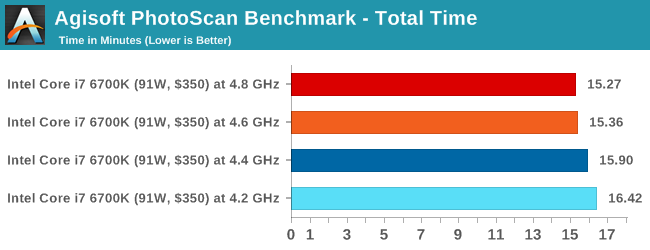
Rendering – PovRay 3.7: link
The Persistence of Vision RayTracer, or PovRay, is a freeware package for as the name suggests, ray tracing. It is a pure renderer, rather than modeling software, but the latest beta version contains a handy benchmark for stressing all processing threads on a platform. We have been using this test in motherboard reviews to test memory stability at various CPU speeds to good effect – if it passes the test, the IMC in the CPU is stable for a given CPU speed. As a CPU test, it runs for approximately 2-3 minutes on high end platforms.
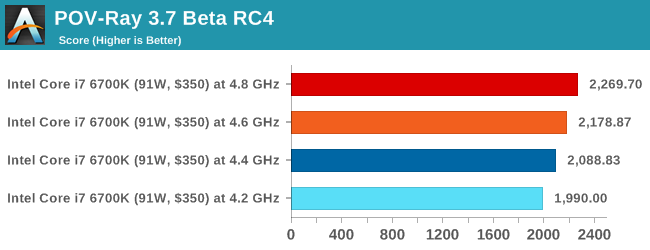
HandBrake v0.9.9 LQ: link
For HandBrake, we take a 2h20 640x266 DVD rip and convert it to the x264 format in an MP4 container. Results are given in terms of the frames per second processed, and HandBrake uses as many threads as possible.
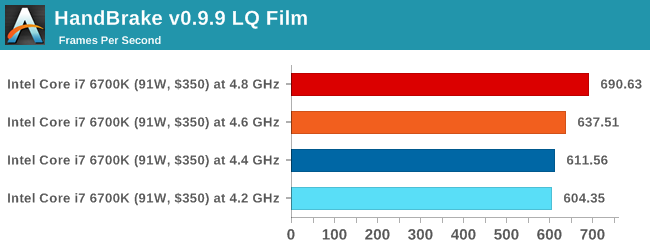
Conclusions on Professional Performance
In all of our professional level tests, the gain from the overclock is pretty much as expected. Photoscan sometimes offers a differing perspective, but this is partly due to some of the randomness of the implementation code between runs but also it affords a variable thread load depending on which stage. Not published here are the HandBrake results running at high quality (double 4K), because it actually failed at 4.6 GHz and above. There is a separate page addressing this stability issue at the end of this mini-review.










103 Comments
View All Comments
StrangerGuy - Sunday, August 30, 2015 - link
If we keep dropping the OC multi on Skylake we are going into single-digit clock increases territory from 4GHz stock :)Yeah, I wonder why AT mentioned in their Skylake review about why people are losing interest in OCing despite Intel's claims of catering to it. From the looks of it, their 14nm process simply isn't tuned for 4GHz+ operation but towards the lower clocked but much more lucrative chips for the server and mobile segment.
qasdfdsaq - Wednesday, September 2, 2015 - link
Then you are deluded. There are edge cases and scenarios that will cause a hardware crash on a Xeon server with ECC RAM at stock speeds, so by your reckoning *nothing* is ever 100% stable.danjw - Friday, August 28, 2015 - link
When can we expect a platform overview? You reviewed the i7-6700K, but you didn't have much in details about them. You were expecting that from IDF. IDF is over, so is there an ETA?MrBowmore - Friday, August 28, 2015 - link
+1hansmuff - Friday, August 28, 2015 - link
I assume the POV-Ray score is the "Render averaged PPS"?My 2600K @4.4 gets 1497 PPS, so a 35% improvement compared to 6700k @4.4
hansmuff - Friday, August 28, 2015 - link
And of course I mean the 6700k seems to be 35% faster in POV... sigh this needs an edit buttonlooncraz - Saturday, August 29, 2015 - link
POV-Ray has been seeing outsized performance improvements on Intel.From Sandy Bridge to Haswell sees a 20% improvement, when the overall improvement is closer to 13%.
HandBrake improved even more - a whopping 29% from Sandy Bridge to Haswell.
And, of course, I'm talking core-for-core, clock-for-clock.
I suspect much of this improvement is related to the AVX/SIMD improvements.
Just hope AMD focused on optimizing for the big benchmark programs as well as their server target market with Zen (this is past tense since Zen is being taped out and currently being prototyped.. rumors and some speculation, of course, but probably pretty accurate).
zepi - Sunday, August 30, 2015 - link
One has to remember, that "handbrake" doesn't actually use CPU-resources at all. The process that is actually benchmarked is running x264 codec with certain settings easily accessible by using GUI called handbrake.If x264 or x265 programmers create new codepaths inside the codecs that take benefit of new architecture, it received huge performance gains. But what this actually means is that Sandy Bridge and Skylake actually run different benchmarks with different instructions fed to processors.
Do I care? No, because I just want my videos to be transcoded as quickly as possible, but one should still remember that this kind of real world benchmarks don't necessarily run same workloads on different processors.
MrBowmore - Friday, August 28, 2015 - link
When are you going to publish the runthrough of the architechture?! Waiting impatiently! :)NA1NSXR - Friday, August 28, 2015 - link
Sigh, still no BCLK comparisons at same clocks. What would really answer some unanswered questions would be comparing 100 x 40 to 200 x 20 for example.